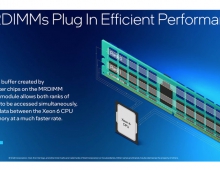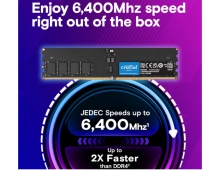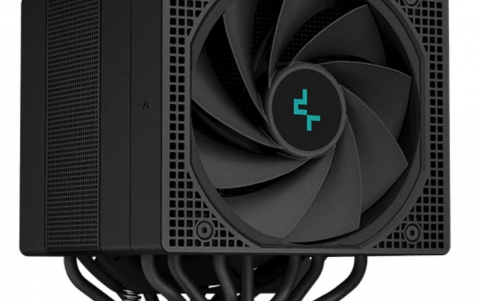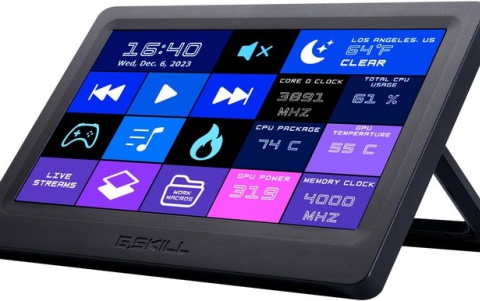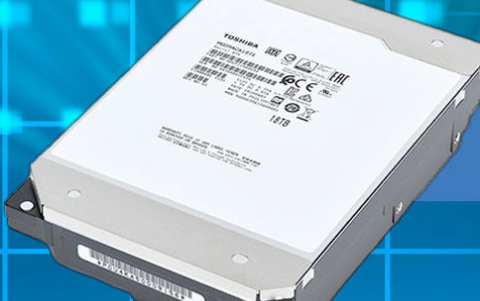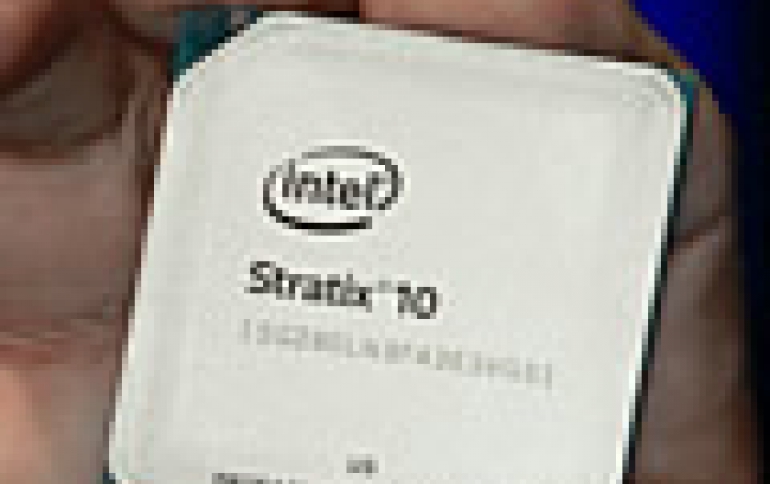
Intel to Accelerate Altera, Autonomous Driving
Intel’s chief executive pledged to support of the former Altera’s base business including use of ARM cores, mapped out the company’s autonomous driving vision and outlined the new Atom T5500 and 5700 chips.
Intel's FPGA Future
Intel CEO Brian Krzanich made it clear during his keynote that FPGAs are a critical part of Intel’s growth strategy, which is being fueled by the virtuous cycle of growth. In a smart and connected world, all the "things" are able to be captured as a piece of data, measured in real time, and be accessible from anywhere.
Intel’s strategy to enable the new smart and connected world reaches all the way from the sensors and actuators to the cloud. And FPGAs and SoC FPGAs will play a central role in enabling this world.
Intel FPGAs break down bottlenecks and accelerate the smart and connected world by delivering flexibility, increased intelligence and higher efficiency. As a multifunction algorithm accelerator, FPGAs and SoC FPGAs provide the optimum mix of hardware and software programmability, according to Intel. This allows system designers to create better systems by exploring which workloads work most efficiently across the CPU and FPGA domain.

"More than 50% of value if the [$16 billion Altera] acquisition was actually tied to growing Altera at a faster rate than it was growing," said Krzanich.
Krzanich pledged to ship before the end of the year Altera’s flagship, the Stratix 10 FPGAs. It will be released under the Intel brand and use both Intel’s 14nm process technology and be the first chip to use its embedded multi-die interconnect packaging technology.
Kraznich promised "no changes in existing or planned products" using ARM cores.

"There is no plan to yank ARM out [of FPGAs] and stick in [Intel architecture (IA)] and make you all change your programming models," he told an audience of FPGA developers. "There are some advanced products that may like an IA core but my guess is the majority of them won’t -- that would be wasted money on our part and trouble for our customers," he said,
"The default processor [to embed in FPGAs] will be ARM -- I want to make sure we kill any of that question or debate," Krzainch said. "There will be some level of performance at the high end with Xeon and FPGAs – we’re shipping a co-packaged product today and we will talk about generating many more of these -- and we think there will be a class of performance at the upper end of the data center that will need these capabilities," he said
Krzanich also reaffirmed Intel is working on products that will combine Xeon server processors, FPGAs and 3D XPoint memories on Intel Omnipath fabrics. However he declined to give any details on such chips or when they will ship.
In addition, he said Intel will commit to product life cycles "well beyond 15 years if that’s what’s required," he said. "The average life time of a silicon technology at Intel is 12 years -- we still manufacture products at 65 nm even though we are starting to sample wafers interally at 10nm," he added.
He also reinforced support for Altera’s low-end products, noting Intel already supports microcontroller-class processors with its Quark as part of its drive into the Internet of Things. "We will have [processors] well below those [Quark chips] coming later," he hinted.
FPGAs and memory are two central parts of computing where Intel aims to differentiate itself, Krzanich said in a nod to its upcoming 3D XPoint memories.
Asked about Intel’s strategy for accelerators given its existing multicore Xeon Phi, new FPGAs and recent acquisition of Nervana, Krzanich said the chips have unique attributes that attract different workloads.
FPGAs shine as accelerators because they can "in a millisecond switch to do another algorithm, so they are very flexible to react to changing workloads," said McNamara.
Asked if Intel’s foundry business will make Altera FPGA fabrics available, Krzanich showed the same agnostic approach he expressed about ARM cores. "We haven’t had anybody ask but I don’t see why not…[as long as Intel is] not giving up our IP," he said.
New Intel Atom processors
Intel's latest generation Atom chips, code-named Broxton, boast significant improvements compared to previous generations.
The new Atom T5500 and 5700 chips have features found in low-end PC processors, but the chips are instead targeted at robots, drones, wearables, and smart home devices.
An important feature is 4K decoding and encoding capabilities, which could allow the chips to be used in virtual reality and augmented reality headsets.
Intel showed smart glasses, a bartending robot, and a smart motorcycle helmet with the Broxton chips at the Intel Developer Forum this week. Intel also said the chips could be used be in storage or media servers.
However, Broxton chips could also find their way to specialized enterprise tablets, and there's a slim possibility that device makers will use the new Atom chips in low-end or thumb stick-sized PCs.
The new Atom chips will support Windows 10 desktop, Windows 10 IoT Core, Linux, Android, and the VxWorks real-time OS.
You can get the new Atom chip through Intel's latest Joule developer board, which like Raspberry Pi 3, is targeted at people looking to build devices. The US$369 Joule 570x has a 1.7GHz Atom T5700 processor, 4GB of LPDDR4 RAM, 16GB of storage, and 802.11ac Wi-Fi.
The T5500 and T5700 chips are based on Intel's latest Goldmont architecture, which will also be in upcoming Celeron and Pentium chips code-named Apollo Lake. The chips draw only six to 12 watts of power.
The 4K video capabilities come thanks to an improved Gen9 integrated graphics processor, which is also in Intel's current batch of chips based on the Skylake architecture. The chips can support up to three 4K DisplayPort and HDMI displays at a 60Hz refresh rate.
There is also a 50 to 80 percent improvement in memory bandwidth compared to the previous Atom chip, based on the Silvermont architecture released in 2015, according to Intel. There is also support for error correction, which was previously available only on Atom server chips.
Autonomous driving
Also at the 2016 Intel Developer Conference, senior Intel executives mapped out the company’s autonomous driving vision. The session outlined the business opportunity, headlined Intel’s end-to-end technology assets and nodded to its investment strategy.
Intel claims it is positioned to deliver "the broadest set of assets" for autonomous driving, powering the intelligence behind the "things," network and the cloud. The morning kicked off with Doug Davis, senior vice president and general manager of the Internet of Things Group.
Intel illustrated how it is positioned to provide all of the components required to power fully autonomous driving with experience that spans the vehicle, communications and the data center. The discussion mirrored the company’s virtuous cycle business strategy. It touched on Intel’s portfolio of power-efficient silicon, global partnerships with telecom and automotive leaders to deliver integrated 5G prototype solutions to ensure network readiness, and the promise of the data center in sufficiently storing, sharing and protecting the unprecedented rates of data that will feed deep learning algorithms to train the vehicle.
120 million vehicles with varying degrees of automation will be on our roads by 2030, creating massive societal and economic ripples. Intel shared predictions for an economic wave that could realize $1.3 trillion in savings for the U.S. economy, $507 billion gained in productivity, $488 billion in accident cost reductions and $138 billion in productivity savings from reduced congestion.

Baidu, China’s dominant search provider, and Intel are evaluating and developing new computing technologies in the vehicle and the data center for autonomous driving that will extend a vehicle’s capability to avoid collisions and make passengers safer.
Intel also summarized the breadth of its automotive strength across silicon, Altera field-programmable gate arrays and Wind River software systems with:
Design Wins:
49 OEM Software Defined Cockpit (SDC)
33 tier-one suppliers
More than 30 vehicle models on the road
Autonomous Engagements:
19 OEM platforms
9 tier-one engagements
59 ecosystem partners
A dozen demos were on display showcasing critical technologies. The demos spanned in-vehicle technologies, communications and analytics, artificial intelligence, machine learning, and human machine interface.


